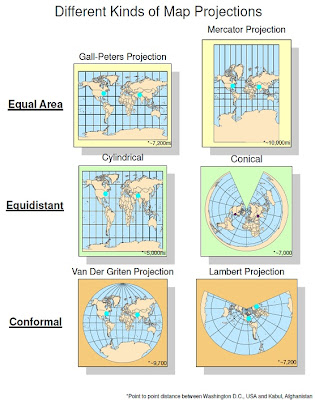This map shows the percentage of African American citizens by county as per the census in 2000. My analysis shows that the largest concentrations of Blacks are in the region of the United States called the "South" or the "Bible Belt". I find it interesting that these percentages do not exceed 85% and would like to research further for possible factors leading to that number. The western half of the United States has a pattern of fairly even distribution of counties with 25% or less Blacks. Also, the far north eastern part of the US located near Maine has a low Black population of less than 10% in that region.
This map alternatively shows the percentage of Asian population by county in the contiguous United States. In my analysis I identified an interesting trend of high percentages in coastal areas, but there are many points that fall outside of this trend such as those found in the Midwest. One may consider the possibility of immigration factoring into this interesting distribution. Compared to the previous examples of Blacks, the areas of high Asian population percentage are of much lower values. Black percentages rose to 85% in some areas while Asian percentages only reach 36%.
This map shows the percentage of White Americans per county in the continental United States based on the year 2000 census data. The analysis reveals patterns opposite to the previously identified patterns of African Americans and Asians. They are opposite because the highest percentages of White citizens are found away from the coasts and not in the Southeastern part of the country. Continuing research into these trends may consider the early expansion and colonization of America which began the spread of White Americans into these regions. Also the areas of highest percentage of Whites exceeds 98%, a much higher figure than the previously identified values for Blacks and Asians.
All 3 of the posted maps show trends that seem to agree with each other. Where one races population percentage is high, the others are low. It would be interesting to overlay such data as numbers of registered voters to explore which communities are likely to vote on upcoming ballots. Similarly it may be interesting to compare these results to the electoral college results from the last presidential election. In all 3 maps, displaying the data in such a concise, visual way makes it much easier to identify spatial patterns in the idea to use in research and other applications. Since humans are visual creatures, visual displays of data are often much more powerful than raw data.
After using geographic information systems (GIS) in multiple applications, the power of the tool has become clear. In each of my labs a large amount of data is involved which would bog down any researcher attempting to analyze the data without the aid of GIS. Thus, GIS allows people to process vast sets of spatial data quickly and easily and create meaningful maps. The computerized nature of GIS also increases accuracy of the results of analysis because all the data is computed not by the user at the keyboard, but internally. This also creates very accurate displays which are very useful for applications such as map projections, where hand drawn images may significantly lose accuracy. In conclusion, GIS is a very useful tool in the age of computing.










